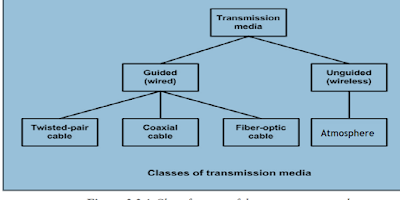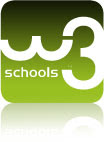Transmission media
Transmission media can be defined as physical path between transmitter and receiver in a data transmission system. And it may be classified into two types as shown in
 |
| transmision media |
Guided:
Transmission capacity depends critically on the medium, the length, and whether
the medium is point-to-point or multipoint (e.g. LAN). Examples are co-axial
cable, twisted pair, and optical fiber
Unguided:
provides
a means for transmitting electro-magnetic signals but do not guide them.
Example wireless transmission.
Guided transmission media
In
this section we shall discuss about the most commonly used guided transmission
media such as twisted-pair of cable, coaxial cable and optical fiber.
Twisted Pair:
 |
| Twisted Pair: |
In twisted pair technology, two
copper wires are strung between two points:
• The two wires are
typically ``twisted'' together in a helix to reduce interference between the
two conductors as shown in Fig.2.2.2. Twisting decreases the cross-talk
interference between adjacent pairs in a cable. Typically, a number of pairs
are bundled together into a cable by wrapping them in a tough protective
sheath.
Can carry both analog and digital signals. Actually, they carry
only analog signals. However, the ``analog'' signals can very closely
correspond to the square waves representing bits, so we often think of them as
carrying digital data.
Data rates of several Mbps common.
Spans distances of several kilometers.
Data rate determined by wire thickness and length. In addition,
shielding to eliminate interference from other wires impacts signal-to-noise
ratio, and ultimately, the data rate.
Good, low-cost communication. Indeed, many sites already have
twisted pair installed in offices -- existing phone lines!
Typical characteristics:
Twisted-pair
can be used for both analog and digital communication. The data rate that can
be supported over a twisted-pair is inversely proportional to the square of the
line length. Maximum transmission distance of 1 Km can be achieved for data
rates up to 1 Mb/s. For analog voice signals, amplifiers are required about
every 6 Km and for digital signals, repeaters are needed for about 2 Km. To
reduce interference, the twisted pair can be shielded with metallic braid.
This type of wire is known as Shielded Twisted-Pair (STP) and the other form is known as Unshielded Twisted-Pair (UTP).
Use: The oldest and the most popular use of twisted pair are in
telephony. In LAN it is commonly used for point-to-point short distance communication
(say, 100m) within a building or a room.
Base band Coaxial
With ``coax'', the medium consists of a
copper core surrounded by insulating material and a braided outer conductor as
shown in. The term base band indicates digital transmission (as opposed
to broadband analog).
 |
| Base band Coaxial |
Physical
connection consists of metal pin touching the copper core. There are two common
ways to connect to a coaxial cable:
. With vampire
taps, a metal pin is inserted into the copper core. A special tool drills a
hole into the cable, removing a small section of the insulation, and a special
connector is screwed into the hole. The tap makes contact with the copper core.
With a T-junction,
the cable is cut in half, and both halves connect to the T-junction. A
T-connector is analogous to the signal splitters used to hook up multiple TVs
to the same cable wire.
Characteristics Of coaxial cable.Co-axial cable has
superior frequency characteristics compared to twisted-pair and can be used for
both analog and digital signaling. In baseband LAN, the data rates lies in the
range of 1 KHz to 20 MHz over a distance in the range of 1 Km. Co-axial cables
typically have a diameter of 3/8". Coaxial cables are used both for baseband and broadband
communication. For broadband CATV application coaxial cable of 1/2" diameter and 75 Ω impedance is used. This
cable offers bandwidths of 300 to 400 MHz facilitating high-speed data
communication with low bit-error rate. In broadband signaling, signal
propagates only in one direction, in contrast to propagation in both directions
in baseband signaling. Broadband cabling uses either dual-cable scheme or
single-cable scheme with a headend to facilitate flow of signal in one
direction. Because of the shielded, concentric construction, co-axial cable is
less susceptible to interference and cross talk than the twisted-pair. For long
distance communication, repeaters are needed for every kilometer or so. Data
rate depends on physical properties of cable, but 10 Mbps is typical.
Use: One of the most popular use of co-axial cable is in cable TV (CATV) for the distribution signals. Another importance use of co-axial cable is in LAN.
People also ask by GOOGLE
Fiber Optics:
In fiber optic
technology, the medium consists of a hair-width strand of silicon or glass, and
the signal consists of pulses of light. For instance, a pulse of light means
``1'', lack of pulse means ``0''. It has a cylindrical shape and consists of
three concentric sections: the core, the cladding,
and the jacket as shown in fig
 |
| Fiber Optics: |
Schematics of three optical fiber types, (a) Single-mode step-index, (b) Multi-mode step-index, and (c) Multi-mode graded-index
The core, innermost section consists of a single solid dielectric cylinder of diameter d1 and of refractive index n1. The core is surrounded by a solid dielectric cladding of refractive index n2 that is less than n1. As a consequence, the light is propagated through multiple total internal reflection. The core material is usually made of ultra pure fused silica or glass and the cladding is either made of glass or plastic. The cladding is surrounded by a jacket made of plastic. The jacket is used to protect against moisture, abrasion, crushing and other environmental hazards.
Three components are required:
1.
Fiber medium:
Current technology carries light pulses for tremendous distances (e.g., 100s of
kilometers) with virtually no signal loss.
2.
Light source:
typically a Light Emitting Diode (LED) or laser diode. Running current through
the material generates a pulse of light.
3.
A photo diode
light detector, which converts light pulses into electrical signals.
Advantages Of Optical fiber cable:
1.
Very high data
rate, low error rate. 1000 Mbps (1 Gbps) over distances of kilometers common.
Error rates are so low they are almost negligible.
1.
Difficult to tap,
which makes it hard for unauthorized taps as well. This is responsible for
higher reliability of this medium.
How
difficult is it to prevent coax taps? Very difficult indeed, unless one can
keep the entire cable in a locked room!
1.
Much thinner (per
logical phone line) than existing copper circuits. Because of its thinness,
phone companies can replace thick copper wiring with fibers having much more
capacity for same volume. This is important because it means that aggregate
phone capacity can be upgraded without the need for finding more physical space
to hire the new cables.
2.
Not susceptible
to electrical interference (lightning) or corrosion (rust).
3.
Greater repeater
distance than coax.
Disadvantages of opticale fiber:
Difficult to tap.
It really is point-to-point technology. In contrast, tapping into coax is
trivial. No special training or expensive tools or parts are required.
One-way channel.
Two fibers needed to get full duplex (both ways) communication.
Fiber cable Uses:
Because of greater
bandwidth (2Gbps), smaller diameter, lighter weight, low attenuation, immunity
to electromagnetic interference and longer repeater spacing, optical fiber
cables are finding widespread use in long-distance telecommunications.
Especially, the single mode fiber is suitable for this purpose. Fiber optic
cables are also used in high-speed LAN applications. Multi-mode fiber is
commonly used in LAN.
. Long-haul trunks-increasingly common in telephone network
(Sprint ads)
. Metropolitan trunks-without repeaters (average 8 miles in
length)
. Rural exchange trunks-link towns and villages
. Local loops-direct from central exchange to a subscriber
(business or home)
. Local area networks-100Mbps ring networks.
People also ask by GOOGLE
framing in computer network || what is framing?
Unguided Transmission:
Unguided transmission
is used when running a physical cable (either fiber or copper) between two end
points is not possible. For example, running wires between buildings is
probably not legal if the building is separated by a public street.
Infrared signals typically
used for short distances (across the street or within same room),
Microwave signals
commonly used for longer distances (10's of km).
Sender and receiver use some sort of dish antenna as shown in Fig
 |
| Microwave signals |
Difficulties:
. Weather
interferes with signals. For instance, clouds, rain, lightning, etc. may
adversely affect communication.
Radio
transmissions easy to tap. A big concern for companies worried about
competitors stealing plans.
Signals bouncing
off of structures may lead to out-of-phase signals that the receiver must
filter out.



إرسال تعليق
have you a any doubt then tell and if you want some topic then please tell .